Hot and Cold Mirrors: Soda-Lime Glass Substrate
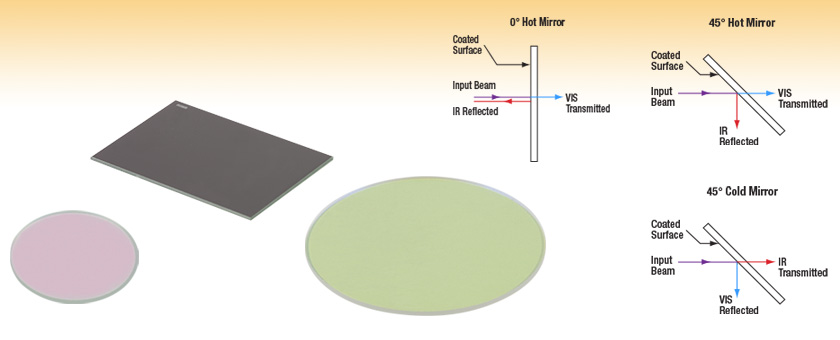
- Protect Heat-Sensitive Setups
- Hot Mirrors Reflect IR Light
- Cold Mirrors Reflect Visible Light
FM01
Ø1" Hot Mirror
FM204
Ø2" Cold Mirror
FM03R
25 mm x 36 mm Cold Mirror

Please Wait
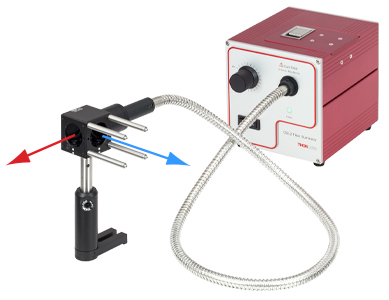
Click for Details
FM03R Visible Cold Mirror (45° AOI) Mounted in CM1-DCH Filter Cube
Separating the Visible and Infrared Light Output from an OSL2 Halogen Source
Features
- Three Sizes Available: Ø1", Ø2", or 25 mm x 36 mm
- High Transmission (>85% Avg.) and Reflection (>90% Avg.) Over Designated Wavelength Ranges
- Available Wavelength Ranges: Red Hot, Near-IR Hot, UV Cold, and Visible Cold
- Soda-Lime Glass Substrate
- Surface Quality: 60-40 Scratch-Dig
- Custom Hot and Cold Mirrors Sizes Are Available by Contacting Tech Support
Thorlabs' Soda-Lime Hot Mirrors are perfect for keeping unwanted heat from reaching sensitive areas of your setup. In applications where heat build up is a concern, 0° or 45° angle of incidence (AOI) hot mirrors provide a means of protection by reflecting the IR beam either back along the input beam path or at 90°. These mirrors also act as a dichroic mirror with a low pass region.
Thorlabs' Soda-Lime Cold Mirrors work to transmit IR energy and reflect the visible light from your setup at 90°. These mirrors are excellent for projection applications and for use as a dichroic mirror with a high pass region.
The KM100T Ø1" optic, KM200T Ø2" optic, and KM2536 25 mm x 36 mm optic kinematic mounts are ideal mounting solutions for this line of hot and cold mirrors. The 45° AOI rectangular mirrors are also compatible with our dichroic filter cubes; for other mounting options, please see our filter mounts. For both types of mirrors, the beamsplitter-coated surface should face the input beam.
If your application requires a substrate with a lower coefficient of thermal expansion, better overall performance, or a more durable coating and substrate, please consider our UV Fused Silica Hot and Cold Mirrors.
We also offer Dichroic Mirrors/Beamsplitters, which provide a greater range of cutoff frequencies.
| Posted Comments: | |
Igor Sh
(posted 2023-07-20 12:23:38.763) How can I distinguisch, which side of the HOt-Mirror is coated? jpolaris
(posted 2023-07-20 01:49:03.0) Thank you for contacting Thorlabs. The coated side of FM01 will appear somewhat reddish-pink in color. This should be distinguishable visually. I have reached out to you directly to discuss this. Derek Pond
(posted 2022-07-08 12:50:02.987) I need a 6" x 6" hot mirror. Do you sell anything that large? jdelia
(posted 2022-07-11 11:56:11.0) Thank you for contacting Thorlabs. Unfortunately the largest hot mirror we offer is 2" in diameter. I have contacted you directly to discuss your application further. nicholas sinclair
(posted 2020-08-17 14:15:44.557) I'd like to use the FM202 2" Hot mirror to reflect 1550nm light (and pass 532nm). Do you have any reflectivity data at 1550nm?
If no, can you offer an estimate of the reflectivity? I can tolerate a fairly low reflectivity (perhaps >30%), so I just want to know it doesn't fall dramatically. YLohia
(posted 2020-08-18 11:03:58.0) Hello Nicholas, thank you for contacting Thorlabs. We have measured the transmission at 1550 nm for the FM202 to be ~89%, so you can expect < 11% reflectivity. The DMSP950L may be a better fit for your application. user
(posted 2019-05-21 14:50:04.317) How is the performance of this mirror at 45 deg incidence?
Do you have a product with similar relfection/transmission characteristics but at 45 deg incidence? YLohia
(posted 2019-05-22 08:44:04.0) Hello, based on our direct discussion of your application requiring the transmission of visible light and the reflection of 700-1000nm, one of our shortpass dichroic filters (for example, the DMSP650) would be better suited to 45 deg AOI use. staskh
(posted 2018-08-15 00:12:44.26) Hello, could you please tell me damage threshold of FM02 for 532 nm 10 ns pulses at 10 Hz. nbayconich
(posted 2018-08-15 02:31:12.0) Thank you for contacting Thorlabs. At the moment we have not yet tested these hot & cold mirrors for pulsed & CW laser damage thresholds. I will contact you directly to discuss your application. amadovelb
(posted 2018-01-24 08:31:43.027) Hello,
I want to use a FM04 UV Cold mirror to combine the light of a 405nm LD and a 532nm LD, at low power around 10mW each. However, the 532nm requires to be shifted from p- to s-polarization in the experiment. How does the performance of this mirror changes with respect to the input polarization?
Thank you,
Amado Velazquez nbayconich
(posted 2018-01-26 02:50:18.0) Thank you for contacting Thorlabs. The transmission of P polarized light will be slightly higher than S polarized light and the reflection of P polarized light will be slightly less than S polarized light. I will reach out to you directly with more scan data for S and P polarization. seungeun
(posted 2017-10-05 13:51:51.97) What is the transmission of Near-IR Hot Mirror below 450 nm? I am interested in 360 nm. tfrisch
(posted 2017-10-11 03:36:22.0) Hello. The raw data over the extended range of 200-1400nm can be found below the graph. I will reach out to you directly to pass it along as well. b.steel1
(posted 2013-02-11 08:39:47.517) Could you please send me data for longer wavelengths (eg as for 1/7/10 post). We are looking at splitting light going up to 2.5 microns.
Thanks! sharrell
(posted 2013-02-15 08:07:00.0) A response from Sean at Thorlabs: Thank you for your feedback. Our optics group is currently scanning these filters and I will post the new plots to the website as soon as they are available. tcohen
(posted 2012-06-21 15:44:00.0) Update from Tim at Thorlabs: The specification was incorrectly placed and has been removed. It is likely that your requirements of ¼ lambda will not be met by these pieces and I will contact you to discuss alternative solutions. Thank you for helping us improve the presentation of these products! tcohen
(posted 2012-06-21 10:53:00.0) Response from Tim at Thorlabs: Thank you for pointing out this discrepancy! We have removed these values as we reconfirm them and we will update the presentation with this data soon. forrest.weesner
(posted 2012-06-15 16:54:42.0) Just checking on interpretation of the specs - The header indicates flatness of 1/10 lamda; the autocad PDF lists flatness as both "n/a" on the print, and also .002 mm in tolerance table.
I need 1/4 lamda or better and wish to clarify what I should expect from this product line. The 1 mm thickness is nice. tcohen
(posted 2012-05-29 12:17:00.0) Response from Tim at Thorlabs: Thank you for contacting us! Changing the angle of incidence will cause a migration of the transmission spectrum, but also may cause some deformations in the profile. We would like to send you a representative curve but do not have your email. To continue this conversation, please contact us at techsupport@thorlabs.com so that we may provide this data. user
(posted 2012-05-26 13:50:50.0) How is performance affected at a 0 degree aoi on the fm204? bdada
(posted 2012-01-26 18:26:00.0) Response from Buki at Thorlabs:
Thank you for your feedback. These mirrors are not meant for imaging applications because there could be some internal wedges or irregularities present in the dielectric stacks, which could cause distortion in your image.
We have contacted you to learn more about your application and assist you further. You can also consider our growing selection of imaging filters to see if one of the filters would be suitable for your application:
http://www.thorlabschina.cn/Navigation.cfm?Guide_ID=2117 juergens
(posted 2012-01-23 08:43:39.0) Due to the small thickness of 1mm astigmatism should be lower than in your dichroic mirrors.
Is it possible to use this cold mirror for high resolution imaging applications (color separation)? Do you know something about the surface flatness, imaging failures? user
(posted 2011-11-30 09:41:45.0) A response from Tyler at Thorlabs: I am not sure which mirror you have, but the FM02 red reflector will perform as you described (red light reflected at 90 degrees and blue light transmitted). The mirror works best when the coated surface faces the light source because that makes it a front surface reflector for the red light. We will contact you to help figure out what needs to be changed in the setup. sshosseini
(posted 2011-11-30 00:44:54.0) Does the mirror have a front surface that needs to face the incoming beam? I thought it should because of the coating but I wasn't very successful of finding it! I used a white light and hoping to get blue colors transmit and the red one reflect but that didn't work as I thought. user
(posted 2011-11-23 17:17:41.0) Response from Tyler at Thorlabs to gediminas.juska: Thank you for posting the question. I know that Pellicle beamsplitters do transmit a higher percentage of p polarized light than s polarized light. I will discuss the measurement of this with our optics group and contact you via email. bdada
(posted 2011-11-22 09:08:00.0) Response from Buki at Thorlabs:
Thank you for your feedback. We have sent you a data file showing the performance of the FM201 wide band hot mirror. At 45 degrees AOI, the transmission curve shifts about 10 - 15nm to the the left. Please contact TechSupport@thorlabs.com if you have any questions. gediminas.juska
(posted 2011-11-21 13:26:31.0) I wonder how (if) a cold mirror (FM03) changes polarization of transmitted light (eg., Does it introduce a phase shift? Does it transmit one linear polarization component more than the other?).
I would like to compare these properties with a pellicle beamsplitter (8:92 uncoated) ones, so if you could comment or provide data about the both of them, I would appreciate that. The wavelength of interest is 800-900nm. Thanks. sshosseini
(posted 2011-11-15 22:18:27.0) Hi Laurie, Thanks for your helpful response. I noticed I have purchased FM201 but I will be using it in a 45 degree angle. I need at least a 2" hot mirror so that is why I got it but would you help me to know how much the mirror response approximately changes and in what direction (blue or red)?
Thank you, Sona lmorgus
(posted 2011-10-24 20:07:00.0) Response from Laurie at Thorlabs to sshosseini: Thank you for your inquiry. If your setup doesn't require kinematic adjustment, our 2" diameter hot mirror can be held in an LMR2 fixed mount using the included SM2RR retaining ring. Alternatively, if kinematic adjustment is necessary, I would recommend our KM200T mount. sshosseini
(posted 2011-10-21 18:16:23.0) I just got my hot mirror and it is very thin. I'm not sure if I can use it with the 2" lens mount I had in mind! How should I mount these thin hot mirror? bdada
(posted 2011-06-21 18:22:00.0) Response from Buki at Thorlabs:
Thank you for using our Feedback Tool, Dr. Folch. We will contact you shortly to discuss your application and determine if we can provide a custom filter that meets your requirements.
Please contact TechSupport@thorlabs.com if you have any questions. jaumefolch
(posted 2011-06-21 20:00:17.0) I am interested in hot reflecting mirrors specially in the range of 600 nm cutoff other than the model FM02 you display.
Best regards,
Dr. Jaume Folch
CIDETE, S.A.
http://www.arrakis.es/~cidete/ Customer Email: jaumefolch@gmail.com This customer would like to be contacted. jjurado
(posted 2011-05-15 15:24:00.0) Response from Javier at Thorlabs to mhensen: Thank you for submitting your request. We will send you a transmission scan of this UV cold mirror shortly. In the meantime, please be advised that the coating is highly absorptive below 325 nm. jjurado
(posted 2011-05-15 15:17:00.0) Response from Javier at Thorlabs to robin.head: Thank you very much for contacting us. We will evaluate the polarization performance of our hot and cold mirrors and let you know the results. In the meantime, I will contact you directly for more details about your application. mhensen
(posted 2011-05-09 04:36:43.0) I am interested in the transmission data of the FM04 in the region down to 300 nm. We are dealing with frequency doubled 6 fs pulses at 800 nm and we want to filter the SHG light ranging from 300-500 nm. jjurado
(posted 2011-04-19 16:44:00.0) Response from Javier at Thorlabs to Lynne: Thank you very ,much for contacting us. As a general rule of thumb, when an optical coating is changed from an angle of incidence of 0 to 45°, the coating band shifts towards a lower wavelength by 10%. The converse is also true. The overall performance of the mirror is not compromised. I will send you a typical transmission graph for the FM03 at 0 and 45 deg. incidence. leigler
(posted 2011-04-06 15:36:00.0) I have an application where I woild like to use a cold mirror at 45 deg but must occasionally flip it to 0 deg. Can you give a curve showing what the performance will degrade to?
Thanks,
Lynne user
(posted 2011-01-27 00:34:27.0) A response from Buki at Thorlabs. You can use the 0 AOI hot mirror at 45 AOI as well. The change, much like an intereference filter, will be a shift of the transmission spectrum towards the blue. Although the shift depends on the effective index of refraction of the filters, I would estimate the shift to be <100nm, thus allowing you to separate your 1064nm source (assuming you are working with the second harmonic, 532nm light). schuldt
(posted 2011-01-26 14:46:08.0) Is it possible to use the Hot mirror in a 45° manner? Wed like to use them to couple out IR light (1064nm) from the illumination path.
Best Greg
(posted 2010-09-30 13:50:03.0) A response from Greg at Thorlabs to mchen: The performance of Cold Mirrors drops off significantly as the AOI changes and goes to 0deg. As you are looking for 95 percent reflection over 450 to 500 nm and 90 percent transmission from 750 to 1300 nm, these mirrors will not be suitable. mchen
(posted 2010-09-29 15:18:36.0) What is the damage threshold of the cold mirror FM03? Can you send me the transmission curve for incident angle of 0 deg? Thorlabs
(posted 2010-07-01 17:44:46.0) Response from Javier at Thorlabs to revans: I have contacted our optics department for generating a transmission scan up to 7 um. In the meantime, I will send you a scan which covers up to 2 um. Regarding the radiant flux, we do not have damage threshold information for this mirror (in radiometric nor photometric terms. We are currently testing many of our optics components, but this hot mirror has not been tested, yet. I will bring this to the attention of our optics department. I will contact you directly in case you are interested in testing this mirror. revans
(posted 2010-07-01 14:23:14.0) Can you send me the transmission for longer wavelengths? up to 7µm would be ideal. Also what is the maximum radiant flux that this optic can handel; thinking about its use in concentrated solar devices. Cheers Adam
(posted 2010-05-20 17:17:49.0) A response from Adam at Thorlabs: We will work on updating the website. In the meantime, if you would like log plots we can supply them. Since no contact information was given, please send an email to techsupport@thorlabs.com with your request. user
(posted 2010-05-18 19:52:45.0) It would really help to have the transmission plots on log scale. In linear scale, it is difficult to see the transmission value, other than nearly zero. For those of us who are interested, the transmission in long wavelength range is missing. apalmentieri
(posted 2010-03-16 12:43:51.0) A response from Adam at Thorlabs: The material of the glass is Soda lime glass. We have updated the website with this information. user
(posted 2010-03-16 12:09:27.0) What material is the glass of these mirrors? BK7? UVFS?
Thanks! |

| Item # | FM02 | FM202 | FM02R | FM01 | FM201 | FM01R |
|---|---|---|---|---|---|---|
| Size | Ø1" | Ø2" | 25 mm x 36 mm | Ø1" | Ø2" | 25 mm x 36 mm |
| Clear Aperture (CA) | >22.8 mm | >45.7 mm | >22.5 mm x 32.4 mm | >22.8 mm | >45.7 mm | >22.5 mm x 32.4 mm |
| Type | Red Hot Mirror | Near-IR Hot Mirror | ||||
| Angle of Incidence (AOI) | 45° | 0° | ||||
| 50% Cut-Off | 580 ± 15 nm | 720 ± 25 nm | ||||
| Transmissiona | Tavg > 85% from 400 to 550 nm | Tavg > 85% from 450 to 645 nm | ||||
| Reflectiona | Ravg > 90% from 610 to 725 nm | Ravg > 90% from 750 to 1200 nm | ||||
| Transmitted Wavefront Errorb | <λ/2 | <λ | <λ Over CA <λ/2 Over Central 22.5 mm Square |
<λ/2 | <λ | <λ Over CA <λ/2 Over Central 22.5 mm Square |
| Dimensional Tolerance |
+0.00/-0.20 mm | ±0.1 mm | +0.00/-0.20 mm | ±0.1 mm | ||
| Parallelism | <3 arcmin Over Clear Aperture | |||||
| Surface Quality | 60-40 Scratch-Dig | |||||
| Thickness | 1.0 mm | |||||
| Thickness Tolerance | ±0.1 mm | |||||

| Item # | FM04 | FM204 | FM04R | FM03 | FM203 | FM03R |
|---|---|---|---|---|---|---|
| Size | Ø1" | Ø2" | 25 mm x 36 mm | Ø1" | Ø2" | 25 mm x 36 mm |
| Clear Aperture (CA) | >22.8 mm | >45.7 mm | >22.5 mm x 32.4 mm | >22.8 mm | >45.7 mm | >22.5 mm x 32.4 mm |
| Type | UV Cold Mirror | Visible Cold Mirror | ||||
| Angle of Incidence (AOI) | 45° | 45° | ||||
| Transmissiona | Tavg > 85% from 600 to 1200 nm | Tavg > 85% from 750 to 1200 nm | ||||
| Reflectiona | Ravg > 90% from 325 to 475 nm | Ravg > 90% from 420 to 630 nm | ||||
| Transmitted Wavefront Errorb | <λ/2 | <λ | <λ Over CA <λ/2 Over Central 22.5 mm Square |
<λ/2 | <λ | <λ Over CA <λ/2 Over Central 22.5 mm Square |
| Dimensional Tolerance |
+0.00/-0.20 mm | ±0.1 mm | +0.00/-0.20 mm | ±0.1 mm | ||
| Parallelism | <3 arcmin Over Clear Aperture | |||||
| Surface Quality | 60-40 Scratch-Dig | |||||
| Thickness | 1.0 mm | |||||
| Thickness Tolerance | ±0.1 mm | |||||
 Products Home
Products Home
















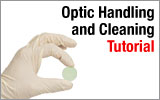
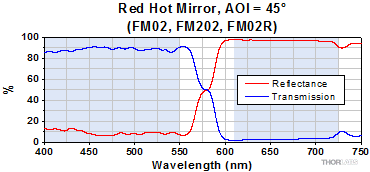
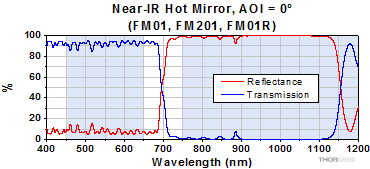
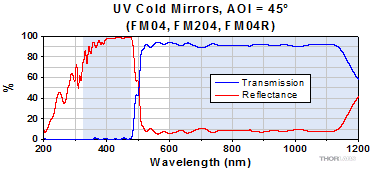
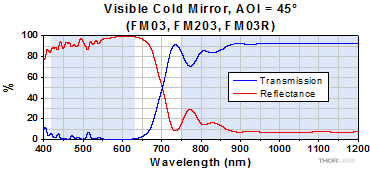
 Soda-Lime Hot / Cold Mirrors
Soda-Lime Hot / Cold Mirrors